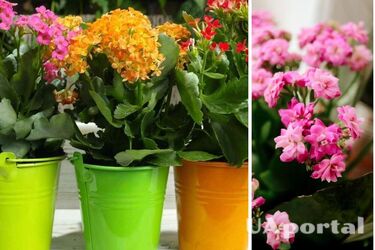How to care for Kalanchoe and make it bloom at home

It is important to follow the basic rules for caring for this plant, and then it will delight you with bright flowering. In many stores, Kalanchoe impresses with its magnificent flowering, and it seems that it blooms all year round. But in fact, this is not the case.
Sellers often use special methods to enhance flowering before selling. Therefore, when buying a Kalanchoe, it is worth knowing that it is a plant that blooms for a certain time and requires certain conditions for this, TSN writes.
Read also: What to add to water to make flowers last longer after the holidays
Kalanchoe blooms once a year, usually in late winter or early spring. With proper care, flowering is possible until mid-spring and even a second flowering in summer.
The main factor affecting the flowering of Kalanchoe is light. The natural process of bud formation begins when daylight hours are reduced. Therefore, it is important to create a short daylight hours for the plant, not exceeding 8-10 hours a day, and stop watering for 3-4 weeks before the expected flowering. If the plant is illuminated for longer, this can interfere with the formation of buds, and the Kalanchoe will not bloom.
Some growers cover the plant from evening to morning using a dark cloth or paper. Another option is to hide the pot in a dark place, such as a closet. The correct temperature conditions should also be observed. Depending on the variety of Kalanchoe, bud formation can take from 10 to 24 days. Under the right light, temperature and watering conditions, buds appear on the plant in early winter, and after a while it blooms for 4-11 weeks.
After the Kalanchoe has finished blooming, it is important to wait until it completely stops blooming and then cut off the old stems. On young plants, you should cut off active growth points, and on adults, remove lignified sprouts to the desired height. This will help form a crown and prevent the Kalanchoe from stretching.
When transplanting the plant, it is important to prepare a larger pot and use soil for succulents. After flowering, you should reduce the frequency of watering, as increased humidity can lead to root rot. You should also regularly fertilize Kalanchoe with complex fertilizers for succulents 2 times a month.
It is important to maintain the optimal temperature for Kalanchoe flowering: the daytime temperature should be between 22 and 27 degrees, and the nighttime temperature should be between 16 and 18 degrees. Keep the plant away from heaters, windows, and balcony doors, as temperature changes can harm the Kalanchoe.
As a reminder, we have already written what is forbidden to do when growing an orchid.
If you want to get the latest news about the war and events in Ukraine, subscribe to our Telegram channel!
